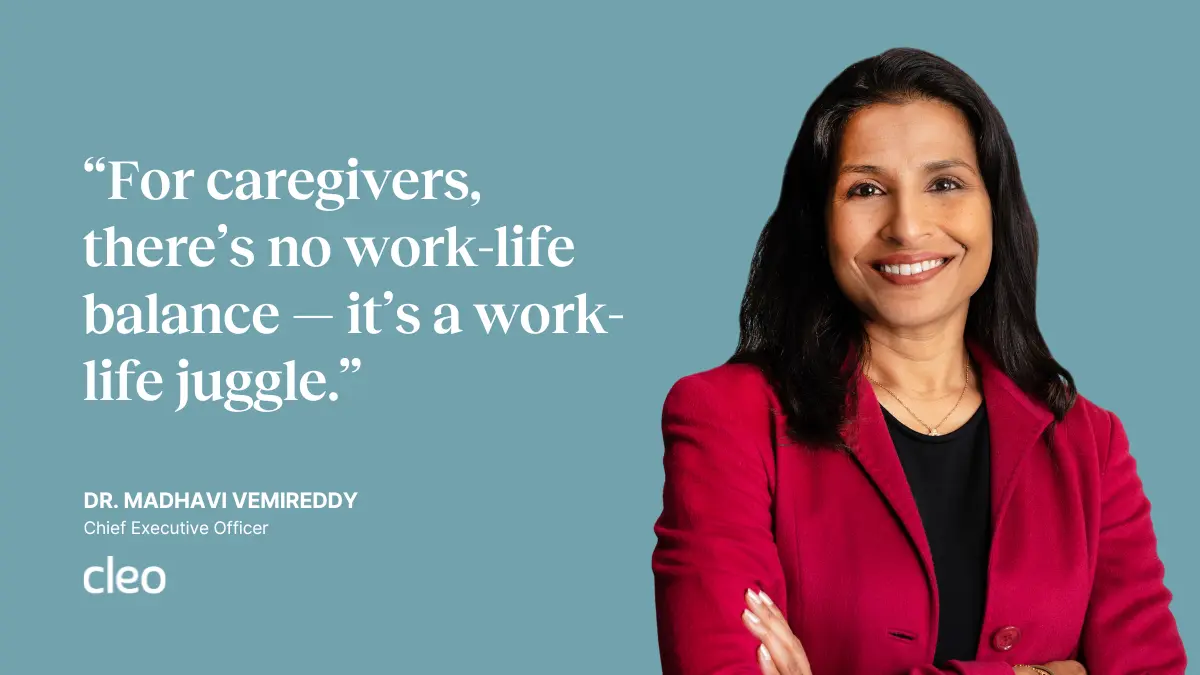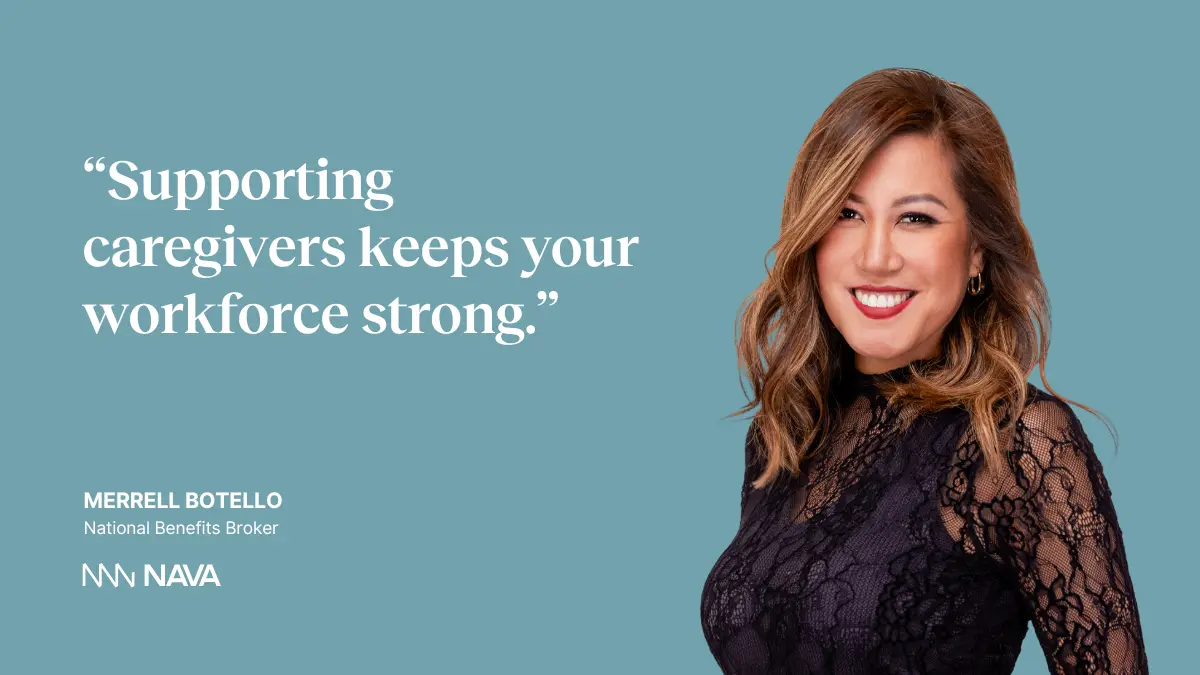How employers can support the sandwich generation with comprehensive care benefits
.webp)
Nearly three-quarters of employees are caregivers, and many are burning out in silence. Nava and Cleo share actionable strategies for HR teams to close benefits gaps, streamline caregiving support, and build stronger, more resilient workforces.
Employees today juggle more than deadlines. They’re managing child drop-offs, doctor visits, aging parents, and the emotional weight of keeping it all afloat.
For the growing sandwich generation, employees caring for both children and aging loved ones, the pressure can feel constant.
It’s no surprise that caregiving is one of the biggest hidden drivers of employee stress, burnout, and healthcare costs.
In a recent webinar hosted by Nava Benefits and Cleo, Nava Partner Merrell Botello and Dr. Madhavi Vemireddy, CEO of Cleo, explored why caregiving benefits must evolve beyond childcare and into full-family care.
Their conversation offered HR leaders a roadmap to better support caregivers year-round.
What percentage of employees are caregivers, and why does it matter?
Research from the Harvard Business Review found that nearly 73% of employees have some form of caregiving responsibility—raising children, supporting aging relatives, or both.
Yet caregiving often stays invisible until it shows up as burnout, absenteeism, or leave of absence.
According to Cleo’s Family Health Index report,
- 60% of caregivers report burnout
- 70% experience depression or anxiety
Behind those numbers are real people—parents skipping their own doctor’s appointments, employees working late after caring for loved ones, and team members quietly burning out.
When caregiving stress goes unaddressed, it can spiral into long-term health issues, lost productivity, and a workplace culture stretched thin by exhaustion.
What is the sandwich generation, and why are they at risk?
The sandwich generation, typically employees in their 40s and 50s, balances raising children and supporting aging parents. Women and people of color make up most of this group, and many reduce hours, decline promotions or leave the workforce altogether, which research links to lower lifetime earnings and smaller retirement savings.
Botello shared her own story of balancing a blended family, elder care, and work. “This isn’t just a benefits conversation,” she said. “It’s a human one.”

How comprehensive care benefits help every family stage
For most employees, caregiving isn’t a single event—it’s a lifelong series of transitions.
A new parent becomes a caregiver to an aging parent. A partner’s health changes unexpectedly. A child’s diagnosis reshapes a family’s routine.
Each stage brings new stressors, systems, and emotional demands. That’s why a “one family, one solution” model matters.
Why a “one family, one solution” model matters
Cleo’s platform connects families with expert guidance across every life stage — pregnancy, parenting, adult care, and elder care — all in one place.
When employees don’t have to juggle multiple vendors or re-explain their story to new providers, they gain:
- Continuity of care: One trusted guide who understands their full caregiving journey
- Reduced stress: Fewer handoffs and less administrative burden
- Saved time: A single platform that simplifies scheduling, referrals, and education
- Earlier intervention: Issues are identified before they become crises
This holistic approach lets caregivers focus on their families instead of navigating fragmented systems.
How Cleo identifies and supports at-risk caregivers
Cleo’s Family Health Index helps pinpoint burnout risk before it escalates. The tool assesses caregiver well-being across seven dimensions, including physical health, mental health, financial stability, and access to resources, then connects members to the right experts for proactive support.
Cleo’s network includes:
- Midwives and lactation consultants
- Parent educators and sleep coaches
- Dementia specialists and neurodivergence experts
- Licensed social workers and mental health professionals
By offering expertise that matches each family’s needs, Cleo delivers care that’s both personalized and preventive.
The measurable impact of simplified care
The results speak for themselves. Cleo’s data show that while up to half of sandwich-generation caregivers are at risk of burnout, members who engage with Cleo’s platform report meaningful reductions in stress and improved overall well-being.
By streamlining access to care and taking coordination off employees’ plates, Cleo helps:
- Reduce burnout risk across all life stages
- Boost productivity and focus at work
- Increase engagement and retention among caregiving employees
Comprehensive care benefits aren’t just about empathy. They’re a measurable investment in workforce health and performance.

What gaps exist in today’s care benefits, and how can HR close them?
Even the most progressive benefits programs often overlook key caregiving needs. Many organizations focus heavily on fertility or parental programs while neglecting elder care, self-care, and the support that employees in the sandwich generation need most.
Understanding the gaps helps HR teams build a more balanced, inclusive caregiving strategy.
1. Over-indexing on early life benefits
Fertility and parental programs are essential, but they represent only part of the caregiving spectrum. When organizations stop there, they miss employees balancing child care, elder care, and personal well-being.
How HR can close the gap:
- Expand benefits to include elder and adult care navigation.
- Audit programs to identify missing life stages.
- Communicate that caregiving support is for everyone, not just new parents.
2. Point-solution fatigue
Managing multiple vendors for mental health, childcare, elder care, and wellness creates administrative headaches and confusion for employees who don’t know where to start.
How HR can close the gap:
- Streamline solutions where possible. Platforms like Cleo, available through Nava’s Preferred Partner Program, unify family care across life stages.
- Integrate programs into your benefits ecosystem so employees experience them as one coordinated system, not a patchwork of tools.
3. The stigma of caregiving
Only about half of employees tell their managers about their caregiving responsibilities, often fearing judgment or career repercussions. This silence keeps them from accessing help until they reach crisis.
How HR can close the gap:
- Create psychological safety through leadership messaging and manager training.
- Launch communications campaigns and caregiver employee resource groups (ERGs) to normalize the conversation.
- Encourage proactive use of benefits before stress or burnout peaks.
4. Limited visibility and data
Many HR teams don’t realize how deeply caregiving affects their workforce until it appears in turnover or absenteeism data. Without visibility, it’s difficult to allocate resources effectively.
How HR can close the gap:
- Include caregiving questions in engagement surveys and health risk assessments.
- Partner with benefits consultants to analyze leave and EAP data for caregiving patterns.
- Use tools like Cleo’s Family Health Index to track well-being and identify early warning signs of burnout.
How Nava and Cleo partner to deliver better care benefits
The Nava–Cleo partnership brings together two complementary strengths:
- Nava’s technology-driven benefits platform, designed to simplify administration for HR teams
- Cleo’s holistic, life-stage caregiving solution, providing continuous family support
Together, they help employers offer end-to-end caregiving support—from fertility and parenting to elder care—without adding administrative burden.
What This Partnership Means for Employers
- Comprehensive coverage: Support for every caregiving stage
- Simplified implementation: Seamless onboarding via Nava’s platform
- Strategic alignment: HR, broker, and vendor collaboration for stronger outcomes
Why this matters in an open-enrollment context
With open-enrollment season on the horizon, HR professionals often face two questions: “How do we simplify a complex benefits landscape?” and “How do we get greater ROI from our benefits spend?” The Nava-Cleo partnership offers a compelling answer: deliver one solution that addresses multiple life stages, reduce vendor complexity, and back it with measurable employee outcomes.
By positioning the partnership this way, HR teams can make the case to finance and leadership that care benefits are not just “nice to have” but central to employee health, productivity, and retention.
How to build the business case for care benefits
Adding a caregiving solution doesn’t have to wait for renewal season. Dr. Madhavi Vemireddy recommends positioning care benefits as a health and productivity investment, not a lifestyle perk. HR leaders can demonstrate that caregiving support directly impacts costs, engagement, and retention. Here’s how to make that case step by step:
Step 1: Identify the scope of caregiving in your workforce
Start by quantifying the problem. Use employee surveys, EAP utilization data, or engagement pulse checks to understand how many employees have caregiving responsibilities, whether for children, partners, or aging parents.
If you can, measure burnout, absenteeism, or turnover patterns tied to these responsibilities. This creates a baseline and shows leadership that caregiving challenges are widespread, not anecdotal.
Step 2: Quantify the hidden costs
Translate caregiving stress into numbers that finance leaders understand. Look at productivity loss, absenteeism, and the cost of replacement or coverage when employees take leave. Even short-term absences can be expensive, and as Dr. Vemireddy notes, “If we can prevent burnout, we can prevent costly leaves of absence.”
Frame caregiving support as a way to reduce preventable costs rather than add new ones.
Step 3: Highlight the ROI of early support
Leverage national data or vendor insights to show how early intervention reduces healthcare claims and turnover. For example, proactive support from caregiving platforms like Cleo can help employees stay healthier and remain in the workforce longer — outcomes that drive measurable ROI through lower claims and reduced leave durations.
Step 4: Align benefits with business goals
Position caregiving benefits as part of your broader wellness and productivity strategy. Emphasize how they complement existing programs like mental health support, EAPs, and leave management. This shows leadership that caregiving is not a siloed expense but a force multiplier for benefits already in place.
Step 5: Secure funding and implementation support
As Nava’s Merrell Botello pointed out, even smaller employers can leverage carrier wellness funds or unused credits to cover part of the cost. These funds are often underutilized, and using them for caregiving support sends a clear message: your organization invests in benefits that matter most to employees.

Key takeaways
- Caregiving is widespread: Nearly three-quarters of employees have caregiving responsibilities, yet many don’t disclose them or access available support.
- The sandwich generation is under pressure: Employees balancing child and elder care face the highest risk of burnout and financial strain.
- Comprehensive care benefits make a measurable impact: Streamlined, whole-family solutions reduce stress, boost productivity, and improve retention.
- Alignment matters: When HR, brokers, and vendors collaborate strategically, caregiving programs deliver stronger outcomes and easier implementation.
- Building the business case is doable: Data, cost analysis, and carrier wellness funds can help HR leaders introduce caregiving support without stretching budgets.
- Culture change is key: Open communication and manager training help reduce stigma and encourage caregivers to seek help before reaching burnout.





.webp)

.png)